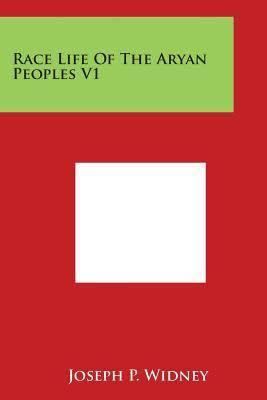Language English Originally published 1907 Publisher Funk & Wagnalls | Publication date 1907 | |
 | ||
Similar Heredity in Relation to Eugenics, The Races of Europe, The Foundations of the Nin, The Rising Tide of Color Ag, The Passing of the Great | ||
Race Life of the Aryan Peoples is a book written by Joseph Pomeroy Widney, published in New York by Funk & Wagnalls in 1907, of the history of the Aryan race, a hypothesized race commonly described in the late 19th and early 20th century as consisting of native Indo-European Language-speaking peoples of Caucasian ancestry, i.e., those ethnic groups that are the native speakers of Indo-European Languages regarded as descended from the original speakers of Proto-Indo European.
Contents
- Outline of the content of the book
- Ethnic groups traditionally regarded as included in the Aryan race
- Introduction to the book
- Editions
- References
At the time the book was published, the Aryan race was generally regarded as one of the three major branches of the Caucasian race, along with the Semitic race and the Hamitic race. These sub-categories are now regarded by some as scientific racism.
Outline of the content of the book
In this massive best-selling two volume work, Joseph Pomeroy Widney, the chancellor of the University of Southern California, describes what he believed was the origin of the "Proto-Aryans" in Central Asia about 7000 years ago, and how they spread out and formed the great "Aryan empires." He included empires which were predominantly Indo-European language-speaking: The Hittite empire, Persian empire, Mauryan empire, Macedonian empire, Roman empire, Gupta empire, Spanish empire, French empire, and British empire, finally resulting in the colonization of North America by the "Aryans", with the entire process culminating in the manifest destiny of the "Aryan Americans" of the United States to establish an American Empire.
Ethnic groups traditionally regarded as included in the Aryan race
The book also discusses the "racial characteristics" of the various subgroups of the Aryan race and their constituent ethnic groups. Widney believed that these characteristics were determined by the soil and climate of the original homeland of each subgroup or individual ethnic group. The original 19th century and early 20th century use of the term Aryan (the original meaning of the term in English), as noted above, refers to "the early speakers of Proto-Indo European and their descendents". Today in academic discourse these human beings would generally be referred to as the Indo-European peoples. These ethnic groups are indicated below:
The Eastern branch includes the Indo-Aryans (including the Maldivians) and the Iranian peoples (including Kurds); the Western branch includes the Armenians, Balts, Slavs, Romani, Albanians, Greeks, Romanics, Teutonics, Celts, Anglo-Americans (includes the European-Americans and the Anglo-Canadians), Québécois, North American White Hispanics, White Latin Americans, Anglo-Australians, Anglo-New Zealanders, British diaspora in Africa, and Boers.
Today, as of 2011, the total population of the Indo-European peoples is approximately 2,405,000,000 people, of which over half, about 1,334,000,000, are those belonging to the Eastern branch of the Indo-European peoples, i.e., the Indo-Iranian peoples; and the rest, about 1,071,000,000, are those belonging to the Western branch of the Indo-European peoples, the European peoples. List of ethnolinguistic groups with populations
Introduction to the book
Every masterful race of the world’s history has its epic. It is the tale of the fathers told to the sons. But side by side with the spoken epic is another, unspoken, yet truer and deeper. It is the tale of the race life, not told in words, but lived in deeds done. And the epic lived is always more wonderful than the epic told. The true epic is found, not in the story of the battles or of the deeds of the rulers, but in the race life. In the perspective of time men become less, man grows greater. Race life is broader, deeper, richer than the life of any man, or of any men. The great men of a race are only an evolution of its race force; and the reserve force is greater than its product. They are indices, race marks. The great man is as the mountain peak; for the mountains that loom up above the widespread plain are not the land; they are only the land-marks, marks of the land. Kings are the accident; the people, the law. The Greek colonies, not Ilium and Atreides Agamemnon, are the true epic of Hellas, vastly more marvelous. So of the Aryan folk; not the Vedas, not the Avestas, not the Iliad, or the Nibelungenlied, or Beowulf, but the marvelous tale of what the Aryan man has lived—how he has subdued the wild and waste lands—how he has made the desert to blossom as the rose—how he has built up empire with ax and plow, and has sailed the unknown paths of the seas—these are his true race epic. The others are only as the fairy tales which old wives tell to their children. We read between the lines of the written epic to find the truer and greater epic which lies beyond. This book is an attempt to unfold somewhat of the race epic which the Aryan peoples have lived. ---Joseph Pomeroy Widney Los Angeles, January 1907.
